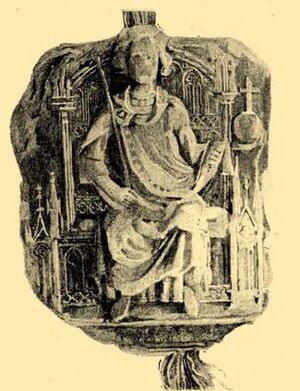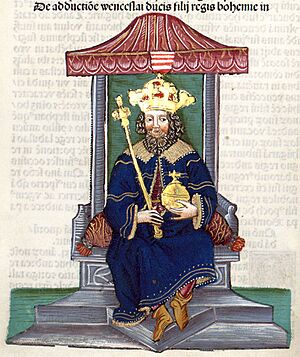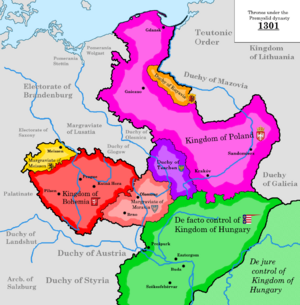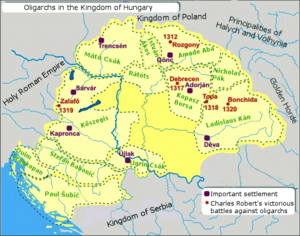Wenceslaus III of Bohemia facts for kids
Quick facts for kids Wenceslaus I (III) |
|
|---|---|

Wenceslaus depicted on his royal seal
|
|
| King of Hungary and Croatia Contested by Charles I |
|
| Reign | 27 August 1301 – 9 October 1305 |
| Coronation | 27 August 1301, Székesfehérvár |
| Predecessor | Andrew III |
| Successor | Otto |
| King of Bohemia | |
| Reign | 21 June 1305 – 4 August 1306 |
| Predecessor | Wenceslaus II |
| Successor | Henry |
| King of Poland contested by Władysław I |
|
| Reign | 21 June 1305 – 4 August 1306 |
| Predecessor | Wenceslaus |
| Successor | Władysław I |
| Born | 6 October 1289 Prague, Kingdom of Bohemia |
| Died | 4 August 1306 (aged 16) Olomouc, Kingdom of Bohemia |
| Spouse | Viola of Teschen |
| Issue | Elizabeth, Abbess of Pustiměřu (illegitimate) |
| Dynasty | Přemyslid |
| Father | Wenceslaus II of Bohemia |
| Mother | Judith of Habsburg |
| Religion | Roman Catholic |
Wenceslaus III (born October 6, 1289 – died August 4, 1306) was a powerful king in Central Europe. He ruled as King of Hungary and King of Croatia from 1301 to 1305. Later, he became King of Bohemia and King of Poland in 1305.
Wenceslaus was the son of Wenceslaus II, King of Bohemia, who also became King of Poland. His mother was Judith of Habsburg. When he was still a child, Wenceslaus was promised to marry Elizabeth, the only daughter of Andrew III of Hungary.
After Andrew III died in 1301, many Hungarian leaders chose Wenceslaus as their new king. However, Pope Boniface VIII supported another person, Charles Robert, to be king.
Wenceslaus was crowned King of Hungary on August 27, 1301. In Hungary, he used the name Ladislaus on his official papers. His power in Hungary was not very strong because many powerful lords controlled large parts of the kingdom. His father realized that Wenceslaus could not gain more power there. So, he took Wenceslaus back to Bohemia in August 1304.
Wenceslaus became King of Bohemia and Poland after his father died on June 21, 1305. He then gave up his claim to the Hungarian throne to Otto III, Duke of Bavaria on October 9.
In Bohemia, Wenceslaus gave large areas of royal land to his young friends. Meanwhile, a Polish leader named Władysław the Elbow-high started taking over Polish lands. Władysław had already begun doing this when Wenceslaus's father was king. Władysław captured Kraków in early 1306. Wenceslaus decided to invade Poland to fight Władysław. But he was murdered before he could start his military campaign. Wenceslaus was the last male ruler from the Přemyslid dynasty in Bohemia.
Contents
Early Life
Wenceslaus III was born in Prague on October 6, 1289. He was the second son of Wenceslaus II, King of Bohemia and his wife, Judith of Habsburg. His older brother died before Wenceslaus was born. Wenceslaus was the only son of his parents who lived past infancy.
His mother, Judith, died on June 18, 1297, when Wenceslaus was still a child. On February 12, 1298, he was promised in marriage to Elizabeth of Hungary. She was the only child of Andrew III of Hungary. Andrew III was the last male member of the House of Árpád, which was the original royal family of Hungary. However, not everyone agreed that Andrew III was the rightful king.
In early 1300, Wenceslaus's father took control of parts of Poland, including Greater Poland and Kujavia. His main opponent, Władysław the Elbow-high, had to leave the kingdom. Wenceslaus II was then crowned king of Poland in Gniezno in September 1300. But Pope Boniface VIII did not approve of Wenceslaus II being king of Poland.
Becoming King of Hungary and Croatia
Andrew III of Hungary died on January 14, 1301, without any sons to take his place. His rival, Charles of Anjou, had long believed he was the true king of Hungary. Charles was a descendant of an earlier Hungarian king, Béla IV of Hungary. When Andrew III died, Charles quickly went to Esztergom. There, Gregory Bicskei, a church leader, crowned him king.
Charles was supported by Pope Boniface VIII. However, Hungarian lords did not like him because they feared losing their freedom if they accepted a king chosen by the Church. Charles's coronation was not done in the traditional way. It did not use the Holy Crown of Hungary and was not held in Székesfehérvár. Because of this, the Hungarian assembly declared Charles's coronation invalid on May 13, 1301.
Jan Muskata, a bishop and advisor to Wenceslaus II of Bohemia, suggested that Wenceslaus II's son, the younger Wenceslaus, should be king of Hungary. The young Wenceslaus was also a descendant of Béla IV. Plus, he was engaged to Andrew III's daughter. Many Hungarian lords and church leaders were convinced by Wenceslaus II's agents. They decided to offer the crown to the young Wenceslaus. They sent a group to his father in Bohemia.
Wenceslaus II met the Hungarian group in Hodonín in August. He accepted their offer for his eleven-year-old son. Wenceslaus II went with his son to Székesfehérvár. There, John Hont-Pázmány, a church leader, crowned the young Wenceslaus king with the Holy Crown on August 27. In Hungary, Wenceslaus used the name Ladislaus on all his official documents.
After Wenceslaus II went back to Bohemia, Jan Muskata became the young king's main advisor in Hungary. Most lords and church leaders accepted Wenceslaus-Ladislaus as king. However, Croatian lords did not. They stayed loyal to Charles of Anjou. Charles moved to the southern parts of Hungary after Ivan Kőszegi, who supported Wenceslaus-Ladislaus, captured Esztergom in August 1301.
Both kings had little real power. Hungary had split into many regions, each controlled by a powerful lord. These lords were called "oligarchs". The Illuminated Chronicle said that the Hungarian lords did not give "a castle, or might and power, or royal authority" to either Wenceslaus-Ladislaus or Charles of Anjou.
Pope Boniface VIII wrote letters to Wenceslaus II and Archbishop John. He said that Wenceslaus-Ladislaus had been crowned without the Pope's permission. A special representative of the Pope, Niccolo Boccasini, came to Hungary in September. He tried to convince Hungarian church leaders to stop supporting Wenceslaus-Ladislaus and support Charles of Anjou.
Wenceslaus-Ladislaus tried to gain support by giving large estates and important jobs to powerful lords. For example, Matthew Csák received two counties and royal castles in February 1302. Ivan Kőszegi became the Palatine of Hungary before April 25, 1302. In the first half of that year, many church leaders, including the new Archbishop of Kalocsa, left Wenceslaus-Ladislaus. Even Jan Muskata left Hungary.
Charles of Anjou tried to take advantage of Wenceslaus-Ladislaus's weaker position. He tried to capture Buda, the capital city, in September 1302. Charles asked the people of Buda to hand over Wenceslaus-Ladislaus. But the citizens, mostly German, and their mayor, Werner, stayed loyal to the young king. Ivan Kőszegi helped defend the city that same month. After Charles of Anjou left Buda, the Pope's representative put the town under a church ban. In response, a local priest declared the Pope and all Hungarian church leaders to be outside the church.
On May 31, 1303, Pope Boniface VIII declared Charles of Anjou the rightful king of Hungary. He said that Wenceslaus-Ladislaus's election was not valid. After this, Albert I of Germany, who was an uncle to both Wenceslaus-Ladislaus and Charles of Anjou, told Wenceslaus-Ladislaus to leave Hungary.
To make his son's position stronger, Wenceslaus II of Bohemia came to Hungary with a large army in May 1304. He captured Esztergom. But his talks with the local lords showed him that his son's power in Hungary had become very weak. So, he decided to take Wenceslaus-Ladislaus back to Bohemia.
Wenceslaus-Ladislaus did not give up his claim to Hungary right away. He made Ivan Kőszegi governor before leaving for Bohemia in August. He even took the Holy Crown of Hungary with him to Prague. Charles of Anjou and Rudolf III of Austria invaded Moravia in September. But they did not defeat Wenceslaus II's army. In the same months, Władysław the Elbow-high, who wanted to be king of Poland, returned to Poland with Hungarian soldiers. He quickly captured many important forts and towns.
King of Bohemia and Poland and His Death
Wenceslaus II of Bohemia and Poland died on June 21, 1305. Wenceslaus III became king of both Bohemia and Poland. But his position in Poland was difficult because Władysław the Elbow-high continued to fight for the Polish throne. Wenceslaus realized he could not keep all three kingdoms. So, he decided to give up Hungary.
Instead of recognizing Charles of Anjou as the rightful king of Hungary, Wenceslaus gave his claim to the Hungarian throne to Otto III, Duke of Bavaria. Otto was also a grandson of Béla IV of Hungary. Wenceslaus gave the Holy Crown of Hungary to Otto in Brno on October 9, 1305. Around the same time, Wenceslaus ended his engagement to Elizabeth of Hungary. He then married Viola of Teschen, following the advice of Bohemian lords.
The sixteen-year-old Wenceslaus enjoyed a lavish lifestyle. He was surrounded by a group of young Czech noblemen. He gave them large amounts of land. His position in Poland became even weaker after Władysław the Elbow-high captured Kraków in early 1306.
To form an alliance against his rival, Wenceslaus gave Gdańsk and Pomorze to Waldemar, Margrave of Brandenburg-Stendal and Herman, Margrave of Brandenburg-Salzwedel as special grants in July 1306. After deciding to invade Poland, Wenceslaus sent away his young friends. He made his brother-in-law, Henry of Carinthia, governor. However, before Wenceslaus could invade, he was stabbed in Olomouc on August 4, 1306. The person who killed him was never found. Wenceslaus was the last king of Bohemia from the original Přemyslid dynasty.
See also
 In Spanish: Wenceslao III de Bohemia para niños
In Spanish: Wenceslao III de Bohemia para niños
- History of Poland during the Piast dynasty
- List of unsolved murders
Sources
Primary sources
- The Hungarian Illuminated Chronicle: Chronica de Gestis Hungarorum (Edited by Dezső Dercsényi) (1970). Corvina, Taplinger Publishing. ISBN: 0-8008-4015-1.
Secondary sources
- Fine, John Van Antwerp (1994). [Wenceslaus III of Bohemia at Google Books The Late Medieval Balkans: A Critical Survey from the Late Twelfth Century to the Ottoman Conquest]. Ann Arbor, Michigan: University of Michigan Press. ISBN 0-472-08260-4. Wenceslaus III of Bohemia at Google Books.
|
Wenceslaus III of Bohemia
House of Přemyslid
Born: 6 October 1289 Died: 4 August 1306 |
||
| Regnal titles | ||
|---|---|---|
| Preceded by Andrew III |
King of Hungary and Croatia 1301–1305 |
Succeeded by Otto |
| Preceded by Wenceslaus II |
King of Bohemia 1305–1306 |
Succeeded by Henry |
| King of Poland 1305–1306 |
Succeeded by Władysław I |
|





